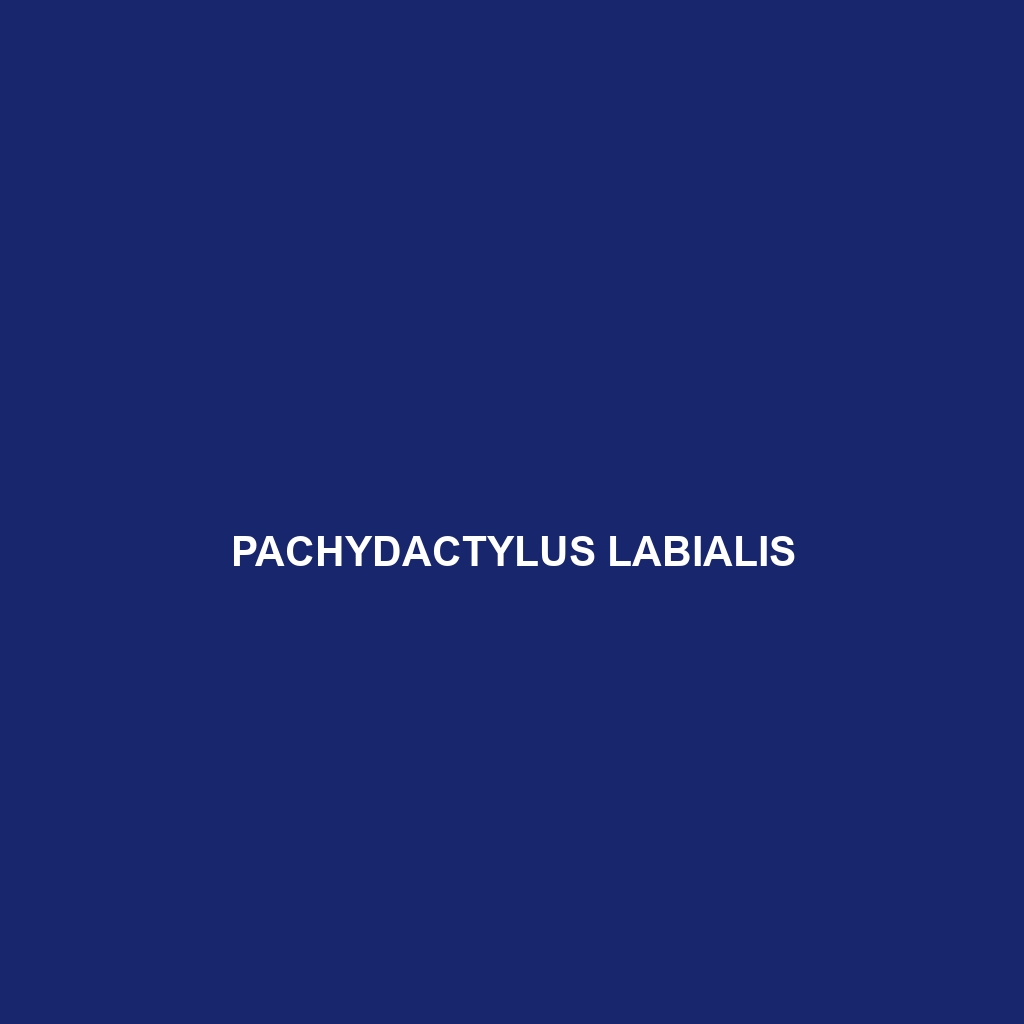Common Name
Pachydactylus labialis
Scientific Name
Pachydactylus labialis
Habitat
Pachydactylus labialis, commonly known as the thick-toed gecko, is primarily found in the dry savannas and grasslands of southern Africa. This species thrives in regions characterized by a semi-arid climate, which includes warm temperatures and sparse vegetation. Their distribution spans across various sub-Saharan countries, including South Africa, Namibia, and Botswana, where they inhabit rocky outcrops, which provide shelter and breeding sites. These geckos can also be found in coastal areas, adapting to both terrestrial and slightly humid environments. The mixed habitats of the African savannas, including patches of scrub and sparse tree cover, create an ideal setting for this hardy reptile.
Physical Characteristics
Pachydactylus labialis displays distinctive physical features that set it apart from other species in the Pachydactylus genus. Typically, they grow to a length of 10 to 12 centimeters (approximately 4 to 5 inches), with a robust body and large, flattened head. Their skin is adorned with a striking combination of earthy browns and soft greys, allowing them to seamlessly blend into their rocky surroundings for camouflage. One of the most notable characteristics is their thick, fleshy toe pads, which aid in climbing rocky terrains and provide grip on various surfaces. Additionally, they possess vibrant yellow or white markings along their dorsal side, contributing to their uniqueness among geckos.
Behavior
Pachydactylus labialis exhibits primarily nocturnal behavior, which enables them to avoid the heat of the day while hunting for food and engaging in social interactions. During the night, they can often be observed foraging for insects and other small prey. Their social interaction extends beyond foraging; males engage in elaborate courtship displays during the breeding season, which includes push-ups and intricate body movements designed to attract females. Notably, these reptiles are territorial, often defending their chosen rock crevices against intruding males. Such behaviors not only emphasize their adaptations to survival but also illustrate the complexity of their social structures.
Diet
The diet of Pachydactylus labialis primarily consists of insects, making them insectivores. Their feeding patterns reflect their opportunistic nature as they consume a variety of prey, including crickets, beetles, and moths. The thick-toed gecko uses its keen eyesight and sensory adaptations to hunt effectively at night, enhancing its ability to catch elusive prey. Their diet may also incorporate small invertebrates found in their habitat, showcasing their adaptability and versatility in food intake.
Reproduction
The reproductive cycle of Pachydactylus labialis typically occurs during the warmer months, which coincide with the insect population’s peak. mating season usually begins in spring, involving males exhibiting courtship behaviors to attract females. After successful mating, females lay one or two eggs in sheltered locations amidst rocks or soil. The gestation period lasts around 30 days, after which the hatchlings emerge fully formed. Parental care is absent, as the young are left to fend for themselves right after hatching. These adaptations enhance the survival chances of the offspring in their natural habitat.
Conservation Status
According to the International Union for Conservation of Nature (IUCN), Pachydactylus labialis is currently classified as “Least Concern”. This classification suggests that their populations are stable across their natural range. However, habitat destruction due to agricultural expansion and urbanization poses potential threats to their environments. Conservation efforts focused on habitat preservation and the establishment of protected areas are crucial to ensuring the continued survival of this species and monitoring population trends in the presence of human activities.
Interesting Facts
One fascinating trait of Pachydactylus labialis is its remarkable climbing ability, attributed to its uniquely adapted toe pads, which allow it to navigate even the most rugged surfaces with ease. Furthermore, these geckos can exhibit impressive tail autotomy, where they voluntarily shed part of their tail when threatened, allowing them to escape predators. The tail can later regenerate, although it may not perfectly resemble the original. This unique adaptation is crucial for survival in a world filled with predators.
Role in Ecosystem
Pachydactylus labialis plays an essential role in its ecosystem as both predator and prey. By preying on insects, they help regulate insect populations, contributing to the ecological balance. Additionally, their presence serves as an important food source for local birds and larger predators, thus forming part of the intricate food web within their habitat. As they traverse their environments, their movements contribute to soil aeration, enhancing nutrient cycling in their ecosystems. Their role highlights the significance of maintaining biodiversity and the health of their ecological systems.
